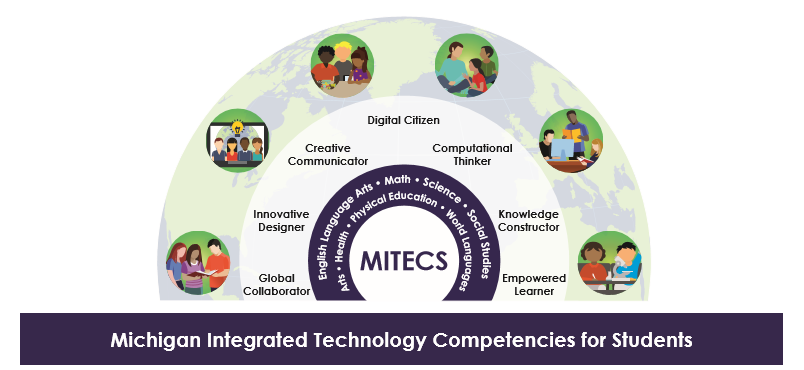Competencies and Standards
When the MiTechKids project began it was purposefully aligned to the seven MITECS competencies.
If we go back in time, technology experts began creating scope and sequences in the 1980s starting at the elementary level to address how computers could be used in the classroom and the computer lab.
Current scope and sequences should take into consideration the changes that have been made in the past 20 years from our students learning basic skills to skills that are designed to empower student voice and ensure that learning is a student-driven process.
In 2018, Michigan adopted the International Society for Technology in Education (ISTE-S) "Standards for Students". Michigan named these MITECS, or the Michigan Integrated Technology Competencies for Students. The decision to identify them as competencies is to delineate a difference between standards that outline learning expectations meant to guide local curriculum development, and competencies, (M. Ribant and Ann-Marie Mapes, Oct 2018 presentation for the Michigan Department of Education at MAME)
MiTechKids is based upon both MITECS and ISTE Standards for Students. The competencies are extremely important as they help teachers know and understand where to embed technology into their content areas. The focus is on learning enhanced by technology versus the technology tool.
STEPS:
To better understand the competencies there are several resources to explore.
1. You should become familiar with the seven competencies in both the MITECS and ISTE Standards for Students: Empowered Learner, Knowledge Constructor, Innovative Designer/Maker, Creative Communicator, Computational Thinker, Global Collaborator, and Digital Citizen.
- These competencies represent a shift from simply using technology to transforming learning through technology.
2. Browse to and review the following document (PDF or Google slides) about MITECS competencies and how they are differentiated from standards.
3. Now that you have an overview of the MITECS, look at the age band articulation document and sample scenarios for students in the age group you work with.
Source: These materials are from the Michigan Techplan.org resources, (1/9/2019)
4. Learn more about the ISTE Standards for Students at the ISTE website.
- There is an excellent book published by ISTE free for ISTE members or $10.95 for non-members with:
- The ISTE Standards for Students.
- Nine scenarios describing authentic learning activities that build Student Standards skills.
- Skills by age band to support the design of learning activities at each level.
- A crosswalk comparing the ISTE Standards for Students (2016) to the Student Standards (2007).
- A prerequisite foundational technology skills scope and sequence document.
5. Take this online quiz to help you learn more about the competencies and standards.
Learning about the competencies and standards are extremely important to:
- understand the task cards on the MiTechKids' website.
- be able to ensure your students are learning the skills necessary to be ready for the future.
Move on to What is a Task Card?
Standards
ADDRESSING THE ISTE STANDARDS FOR EDUCATORS
Learner
1a. Set professional learning goals to explore and apply pedagogical approaches made possible by technology and reflect on their effectiveness.
1c. Stay current with research that supports improved student learning outcomes, including findings from the learning sciences.
Leader
2b. Advocate for equitable access to educational technology, digital content and learning opportunities to meet the diverse needs of all students.
2c. Model for colleagues the identification, exploration, evaluation, curation and adoption of new digital resources and tools for learning.

